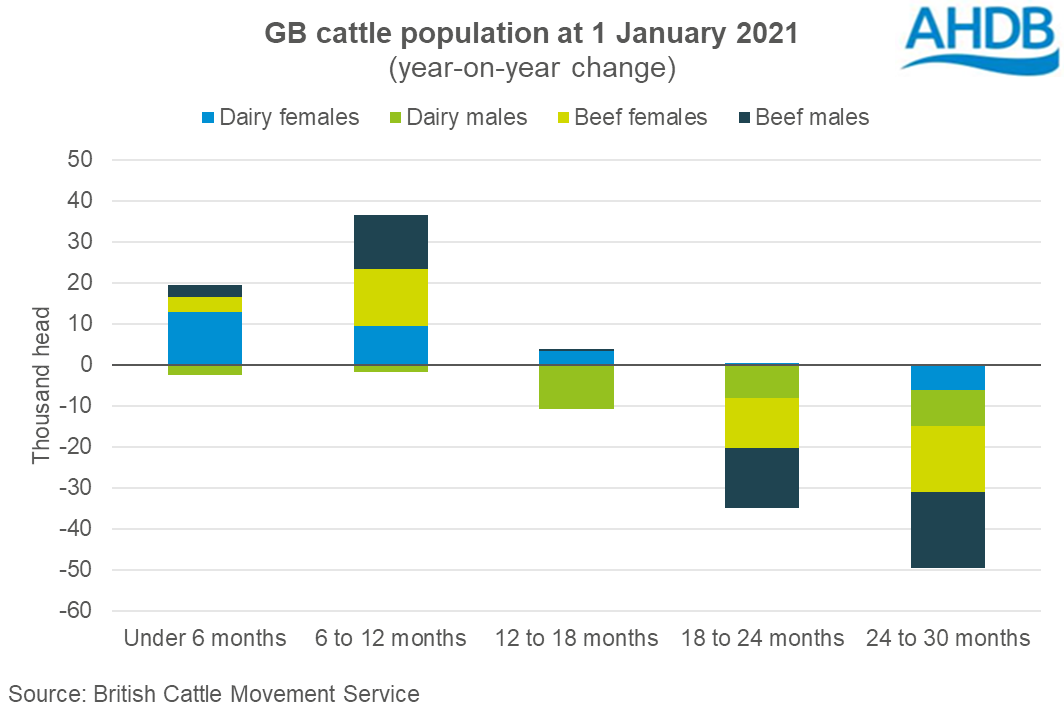January 2021 cattle market outlook... where are we now?
Tuesday, 27 April 2021
It’s now three months since we published our latest Agri-Market Outlook for beef in January. Let’s take a look at how our forecasts have performed against what has actually happened so far.
Cattle slaughter
In January, we forecast that UK prime cattle and cow slaughter would fall by around 5% year-on-year in 2021. We based this on several factors. Data from both the British Cattle Movement Service and Defra have been indicating lower numbers of cattle available for slaughter in 2021. We anticipated that higher-than-expected slaughter in 2020 would compound this further.
We also forecast that there would be some easing in domestic beef consumption in 2021. This was based on the expectation that some foodservice would reopen towards the end of the year, and retail sales would ease.
During the first quarter of 2021, Defra figures show UK prime cattle slaughter totalled 501,400 head, which is currently down 3% from the same period a year ago. This is less of a contraction that we expected to see at this stage. Slaughter of cull cows during the same period totalled 157,500 head, which is down 5% year-on-year, slightly ahead of expectations.
Cattle population data released since the outlook was published has continued to show tightness in prime cattle supplies, with numbers down 5% year-on-year in January. However, cattle prices have continued to climb since the start of the year; the GB all-prime average price broke the £4/kg mark in the week ending 17 April.

This supports reports of strong competition for available supplies, and could explain why slaughter has not fallen as much as we expected so far. Data for beef males suggest that prime cattle are being slaughtered younger than they were in 2020, potentially reflecting the strong demand.
Beef production
In January, we forecast that UK beef and veal production would fall by 5% in 2021, reflecting lower cattle supplies and lower domestic consumption. For the first quarter of the year, Defra figures show that beef production totalled 227,600 tonnes, which is down 3% year-on-year. Higher-than-expected cattle slaughter so far will have contributed here, although it’s still early days as far as the full year is concerned. Average prime carcase weights have been virtually unchanged on the year, while cows have been slightly heavier.
Trade
We forecast that beef imports would rise by around 4% year-on-year in 2021. This increase would be weighted towards later in the year due to lower domestic production and reopening of foodservice markets later in the year. We forecast that exports would contract by 3%, driven by lower domestic production, slow recovery in European foodservice markets and post-Brexit trade friction. Lower imports would be expected towards the beginning of the year.
The latest HMRC trade data shows that UK imports of beef (including fresh & frozen cuts, processed beef and offal) during the first two months of the year fell 36% compared to the same period a year ago. Exports were reportedly down 71% year-on-year for the same period.
While post-Brexit trade friction will have affected volumes traded since the start of the year, it’s important to note that the way in which the data is collected changed in January, which could be distorting the picture somewhat. Revisions to the data could be likely in future; although it is still strongly evident that trade in both directions has contracted sharply.
It is therefore difficult to draw too many conclusions as to what the current trade data means in the context of our forecasts for the whole year at the moment. We will of course continue to monitor the data closely as more becomes available.
So, what next?
We will be publishing our next outlook in July. In the meantime, you can read a longer-term outlook for UK red meat markets here.

Sign up for regular updates
You can subscribe to receive Beef and Lamb market news straight to your inbox. Simply fill in your contact details on our online form.
While AHDB seeks to ensure that the information contained on this webpage is accurate at the time of publication, no warranty is given in respect of the information and data provided. You are responsible for how you use the information. To the maximum extent permitted by law, AHDB accepts no liability for loss, damage or injury howsoever caused or suffered (including that caused by negligence) directly or indirectly in relation to the information or data provided in this publication.
All intellectual property rights in the information and data on this webpage belong to or are licensed by AHDB. You are authorised to use such information for your internal business purposes only and you must not provide this information to any other third parties, including further publication of the information, or for commercial gain in any way whatsoever without the prior written permission of AHDB for each third party disclosure, publication or commercial arrangement. For more information, please see our Terms of Use and Privacy Notice or contact the Director of Corporate Affairs at info@ahdb.org.uk © Agriculture and Horticulture Development Board. All rights reserved.

